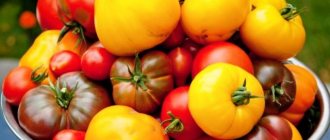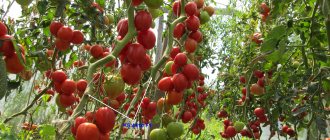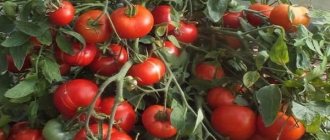The best potato varieties are the most delicious and productive allow you to grow a rich harvest that can be stored until spring.
The taste of potatoes depends on the variety and timing of ripening, the amount of starch in the fruit, storage conditions, etc. Some varieties are good for frying, others are suitable for boiling, and there are universal varieties. Potatoes are divided into technical, fodder, table and universal types. Depending on the growing region, choose the appropriate variety. Next, we will consider the most delicious and productive varieties.
Rating of potato varieties
Potatoes are one of the most common vegetable crops grown in gardens and vegetable gardens. When compiling the review, our team used people’s reviews, expert opinions, and photos. While studying the material, several characteristics were identified that people considered as priorities. These were:
- Maturing period;
- Keeping quality;
- Purpose;
- Starchiness.
The reviews also helped to establish the advantages and disadvantages of the nominated varieties.
The best early potato varieties
Early potato varieties are ready for harvesting 45–66 days after planting the seeds. Requires minimal care. Immune to late blight - do not meet deadlines. They are not stored for storage - they quickly wither and lose their taste.
Bellarosa
Table variety, zoned for cultivation in the North-Western, Central Black Earth, Volga-Vyatka and Ural regions.
It is recommended to do digging at 44–46 days. The root system “grows” up to 6 rather heavy potatoes. The starch content is 12–16%, so the vegetable performs well in fries and when fried.
Tall, compact. It blooms with inflorescences of rich red color with purple nuances. Tubers weighing 115 - 195 g are oval-round with a pinkish-red shell, light yellow when cut.
Advantages:
- Marketability 99%;
- Long shelf life;
- Adapted to high temperatures, drought;
- Undemanding to land when planting.
Flaws:
- There are few small tubers - there is no opportunity to make a choice for planting;
- Severely damaged during digging.
Alyona
Dutch variety. Unpretentious - gives good yields on “poor” lands and in short summer conditions. Forms large tubers within 1.5 months after planting. Fully ripens on the 50th day.
The bush is low, slightly spreading. The leaf is small, slightly wavy along the edge. Inflorescences of several white flowers. The roots are powerful - they grow up to 20 root crops. Fully ripened tubers are large: weight can reach 150 – 200 g. Oval, smooth. The peel is light yellow, thin. The pulp is yellow or cream in color.
Starchy index – 14%. The variety performs well in soups, as well as when preparing purees, fries and baking.
Advantages:
- Universal in cooking;
- Tolerates drought well;
- Does not degenerate - the harvest is used for replanting.
Flaws:
- Requires regular watering and loosening.
Lapis lazuli
The variety came to us from Belarus, intended for breeding in the Central, Volga-Vyatka and Central Black Earth regions. Ready for digging in 60 – 71 days.
The potatoes are not very large - the average weight does not exceed 110 g. When cut, they are dense and white. The peel is strong and yellow. Eyes are found, but rarely.
The tops are strong, durable, and do not fall apart. Height – no more than 50 cm. The number of tubers in the nest is from 6 to 11 pieces. All are large or medium, there are never small things.
Advantages:
- Adaptability to different weather;
- Tolerates drought well;
- Low susceptibility to diseases;
- Harvest stability.
Flaws:
- Poor resistance to late blight.
The best deep fryers
Culinary tricks
Preparing puree is not difficult, but there are some nuances here too.:
- Overcooked potatoes will only improve the taste of the dish. Hard tubers are difficult to mash into puree, and pieces remain in the finished dish.
- Pour a little water into the pan so that the potatoes steam more.
- In order for vegetables to cook better and faster, they are completely peeled and cut into large pieces.
- After cooking is completed, the water is poured into a separate container. Little by little liquid is added to the puree, making it softer.
- To create a delicious dish, take half the water in which the potatoes were boiled and half fresh milk.
- Do not add cold water to the product - this will cause the taste and attractive color to be lost. It is advisable to cook the tubers in enamel dishes - in aluminum and iron pans they turn grayish.
- Before adding water and milk to the mashed potatoes, salt the mashed potatoes. The liquid will dissolve the salt, and when stirred, it will be evenly distributed throughout the mass.
The final touch is to add a little butter to the still hot puree to give it a special taste.
The best mid-season potato varieties
Ripening period – up to 100 days. They are grown for winter storage due to their good keeping quality: sprouts appear as soon as the weather warms up.
Scarlett
Harvesting can begin 70–80 days after the first shoots appear. The bush is often low, although sometimes it reaches 50–60 cm. The tops are erect, of medium thickness. The color is moderate anocyanin. The leaf is small in size, rich green in color, matte with a slight wave along the edges. The flowers are painted in a beautiful red-violet color.
Root vegetables weighing 60–125 g, oval-oblong, in a red shell with yellow flesh. The surface is even, may be smooth, but sometimes there is a slight roughness.
In terms of its intended use in cooking, it is universal. The tubers are practically not overcooked, crumbling is minimal. After exposure to temperature, the pulp retains its color. According to tasting samples, it receives a score of 7 points out of 9 possible.
Advantages:
- High yield;
- After cooking, retains its shape;
- Good immunity.
Flaws:
- The need to comply with agricultural cultivation techniques;
- Demanding on weather conditions.
Marfona
The development was carried out by breeders from Holland. It belongs to the group of mid-season ones - you can dig 65-75 days after the first shoots appear above the ground. The harvest is best in the Central, Central Black Earth and Lower Volga regions.
An oval-shaped root crop weighing 80–110 g. The nest includes from 8 to 12 tubers. With strict adherence to agricultural technology conditions, 180 - 378 centners can be removed from 1 hectare. The peel and pulp are yellow.
The taste, according to reviews, is good. In culinary terms, it belongs to group A. The dry matter content does not exceed 10%, so potatoes are equally good in soups and salads.
Advantages:
- Starch content 10%;
- If the cultivation rules are followed, it gives good yields.
Flaws:
- Often suffers from scab and leaf roll virus.
Gala
Canteen, you can start selective cleaning on days 74–76.
The plant has medium-sized tops. The foliage is large. The inflorescences are medium, snow-white. The shape of the potatoes is an elongated oval. There are eyes, but they are small. The skin is without roughness and, like the flesh, has an intense yellow tint. The weight of the root crop is from 70 to 120 g. You can remove up to 20 - 25 pieces from one bush.
Starch content 10 – 13%. During heat treatment, the tuber does not fall apart. It turns out especially tasty when fried. Goes well in salads.
Advantages:
- Large "nest";
- Little susceptible to late blight;
- The eyes are small;
- The tubers are quite large.
Flaws:
- Demanding on soil quality;
- It germinates early.
The best potato diggers for walk-behind tractors
"Red Scarlett"
A high-yielding variety for red potato lovers. From one bush you can get up to 15 oval-shaped tubers weighing from 80 to 150 g. The yellow flesh is visible on the cut. "Red Scarlett" is a hybrid of Dutch selection. Potatoes tolerate lack of moisture and hot weather well, so they can be successfully grown in the south.
Large-fruited peppers: 5 varieties worth paying attention to
The growing period lasts about 70 days. From one hundred square meters they get up to 660 kg of harvest. During the cooking process, potatoes do not lose their color. The starch content is low (11-15%), which allows the tubers to maintain their shape during cooking. The harvest is perfectly stored for a long time, keeping quality is 98%. Gastronomic characteristics at a high level. The variety is demanding to care for and requires adherence to agricultural technology.
The yield of potatoes largely depends on the care of the plantings. The quality of planting material also plays an important role. It is better to purchase it at specialized retail outlets that have a certificate for the product. The best results are shown by tubers belonging to the elite category.
The most delicious varieties of potatoes
The composition is responsible for the “deliciousness”. It contains a high percentage of dry matter, fiber and amino acids. Delicious potato varieties in our rating are represented by three types.
Picasso
Late ripening, table. It owes its name to the original coloring of the tubers.
The bushes grow medium in height and spreading. The tops get a rich green tint. The flowers are white, miniature. They bloom quickly.
The potatoes are large and oval shaped. Slightly yellowish when cut. The color of the peel is very unusual: a combination of pink and yellow shades.
Advantages:
- Good yield;
- Lies for a long time, without germination;
- Easily tolerates heat;
- Resistant to many diseases.
Flaws:
- Needs constant feeding;
- Not intended for regions with short summers.
Queen Anne
Belongs to the group of early ripening ones; it appeared in the State Register of the country relatively recently. You can begin selective harvesting of “new” potatoes 85 days after the appearance of greenery. Suitable for any climate zones.
The tops do not grow too high. The bush turns out to be semi-erect, but it sags under its own weight only in the second half of the growing season. The leaves are large, bright green. The inflorescences are snow-white.
Tubers - if the cultivation technique is followed - turn out to be the same shape, oval-oblong. The weight of the root crop is up to 100 g. There are eyes, but very small, almost invisible. The peel and pulp are yellow. Starch content is at the level of 13 – 14.5%.
Advantages:
- Keeping quality 93%;
- Unpretentious to grow;
- High-yielding.
Flaws:
- It takes a long time to rise, not amicably.
Tuleevsky
It was received by domestic specialists and included in the list of vegetables approved for cultivation in Russia in 2007. It was named in honor of Aman Tuleyev, the governor of the Kemerovo region.
It belongs to the group of mid-season varieties: tubers can be harvested 80–100 days after planting. The bushes are low - up to 55 cm, resistant to lodging. The inflorescences are large, beautiful, creamy white.
With proper care, you can remove 11–15 tubers from one plant. They are large, weighing from 115 to 270 g. Sometimes there are truly weighty specimens - up to 500 g. The shell is light beige, covered with a mesh pattern. The cut reveals white or slightly yellowish flesh.
Potatoes have a high shelf life - up to 90%. Starchy index – 17%.
Advantages:
- Good return;
- Large root vegetables;
- Suitable for almost all regions;
- Keeping quality at a high level.
Flaws:
- The appearance of voids in the pulp due to a lack of mineral fertilizers;
- Not recommended for lands with shallow groundwater.
The most productive potato varieties
They can produce at least 350 c/ha. With strict adherence to agricultural technology, the figure can reach up to 800 c/ha. Determining which potato variety is the most productive, the VyborExpert.ru team, based on reviews, selected three nominees for the category.
Hussar
It belongs to the mid-season category - you can pick up a shovel after 85 - 90 days. Gusar is almost an absolute newcomer: it appeared on the market in 2022. It is characterized by high yield - up to 550 c/ha - and good keeping quality. Up to a dozen potatoes can ripen on one bush, each weighing up to 185 g.
The tops grow tall, with erect shoots. The shell of the root crop is light brown, yellowish when cut. Thanks to its high starchy content - 17.5% - it is famous for its good taste.
Advantages:
- Low dependence on weather conditions;
- Lying;
- Resistant to the most common potato diseases;
- Withstands drought of any duration.
Flaws:
- Suffers from late blight and scab.
Giant
A productive table variety of mid-season ripening, included in the State Register in 2013. Grows tall, semi-erect bushes. Tops of medium spreading and moderate foliage. The color is small, red-violet. Inflorescences are compact.
The tubers are oval-round, large - weight up to 100 - 140 g - smooth. The peel is smooth, medium thickness, light beige. The eyes are small, few of them, and reddish. The pulp is creamy.
The dry matter content is high: from 16 to 19%. The pulp does not oxidize (does not darken) when exposed to air. After cooking it does not fall apart, it becomes tasty and aromatic.
Advantages:
- Resistant to degeneration;
- Adaptation to drought;
- Good keeping quality.
Flaws:
- Intolerance to soil waterlogging;
- Doesn't like loam.
Lasunak
A relative novelty that attracts gardeners with its good taste and productivity. Belongs to the group of mid-season varieties - the ripening period is 90 - 120 days - undemanding in care, resistant to major crop diseases. You can get 10 – 17 root vegetables from a nest. The indicator depends on weather conditions and compliance with agricultural practices.
The bush is multi-stemmed, but not spreading, compact. The dark green leaves are covered with hard hair, which protects them from being eaten by the Colorado potato beetle. Blooms long and powerfully.
The tuber is large - from 120 to 180 g - oval with a yellowish peel and the same pulp. There are few eyes. They are planted deeply, but this does not affect the germination rate. Keeping quality is average: if you do not comply with storage temperature requirements, it begins to actively grow.
Advantages:
- After defrosting, retains its taste;
- Cooks well, crumbly;
- High yield;
- Unpretentious to grow;
- Immune to plant diseases;
- Resistant to the Colorado potato beetle.
Flaws:
- Germinates very early;
- Requires regular watering.
Separation of varieties by color
Based on the color of the peel, all varieties are divided into three main groups: yellow (various shades), red and purple. In each of these groups, there may be white or yellow flesh under the skin; purple varieties have purple flesh, respectively.
The color of the skin does not have a significant effect on the quality of the potato. At the same time, the darker the color of the pulp, the more carotene or anthocyanins it contains. These varieties, in addition to being tasty, are also healthy. And another advantage of such varieties is that they are more resistant to unfavorable growing conditions.
The best potato varieties for mashed potatoes
To prepare tasty purees, it is recommended to choose varieties containing at least 16% dry matter. The review category is represented by two types of potatoes.
Charoite
Allows you to get up to two harvests per season. The variety has become widely known since 2014. It shows itself best in the North-West region and Leningrad region. But he receives good recommendations from gardeners from other regions of the country.
The root crops are elongated-oval, quite large - weight from 95 g to 145 g. The starch content is high - the figure is 14 - 17%. Thanks to this, it boils well in puree and is also suitable for baking.
Early ripening - you can dig up the first bushes after 45 days. It reaches technical ripeness 50–60 days after emergence.
Advantages:
- Universal;
- Resistance to cool climates;
- Early ripening.
Flaws:
- Demanding on soil fertility;
- If agricultural practices are not followed, it is affected by late blight.
Fairy tale
Early, development. On the register since 2004. Approved for landing in the Far East, the Urals and the Middle Volga region. It also performs well in warmer areas, but in this case it requires abundant watering.
The bush is powerful, medium-sized. The inflorescences are red with purple hues, large. With good management, you can remove up to 30 root vegetables from the bush, weighing 76 - 129 g. The peel is yellow, the flesh is almost white.
The taste is good due to the high starch content - from 13% to 17%. Boils moderately. Suitable for salads and stir frying.
Advantages:
- Up to 30 potatoes in a nest;
- Cooks moderately;
- Keeping quality 91%;
- Recommended for cold regions.
Flaws:
- Large eyes.
"Slav"
Potatoes with medium-late ripening periods. 120 days pass before the mass harvest. Slavyanka is a table variety. In one nest, 13-15 tubers are formed with an average weight of 180 g. The shelf life indicator is up to 95%. Tubers contain 11-13% starch.
When cut, the potatoes are cream-colored, the skin is pink, with a purple tint. From one hundred square meters you can get more than 500 kg of potatoes. The variety successfully resists viral infections, cancer, late blight, scab, Alternaria, and wrinkled mosaic, but can be damaged by the Colorado potato beetle and wireworm. Since the variety is late, it is well stored without loss of taste and commercial qualities.
The best potato varieties for long-term storage
For storage, it is recommended to select varieties of medium and late ripening. They are thick-skinned, resistant to fungal infections, and do not rot. The characteristics of potato varieties helped us nominate three varieties of vegetables in the category.
Tiras
Tiras is the development of early ripening breeders from Ukraine. Attractive to gardeners due to its resistance to dry periods. Unpretentious to the type of land. To ripen, the potatoes need to “sit” in the ground for 70–85 days. But you can start digging up the first bushes on the 40th growing season.
The variety does not produce tall tops, but grows spreading and well-leafed. Inflorescences are red-violet. The root system is developed, capable of forming up to 9 – 12 large – weighing up to 140 g – oval-shaped root crops. Starch content from 10 to 14.5%.
Advantages:
- Unpretentious to the weather;
- Tolerates even prolonged drought;
- Storage period without loss of commercial quality – 7 months;
- Can produce two harvests per season.
Flaws:
- Low immunity to late blight.
Slav
Bred in Ukraine by breeders of the Kirovograd Institute of the Ukrainian Academy of Agrarian Sciences. Included in the Russian State Register in 2009. Experts recommended it for planting in the Central Black Earth region, but the variety is widespread everywhere.
Slavyanka is never tall - the tops are no more than 50 cm. The bush is lush and spreading, but the leaves are relatively small. Produces root vegetables of an elongated oval shape, with a thin pinkish-purple skin. The weight of one is in the range of 100 - 250 g. But sometimes larger specimens grow.
The variety is late-ripening - it takes 100 - 120 days to accumulate the declared starchy index. High-yielding: you can get up to 300 kg per hundred square meters. If you follow the developer’s recommendations on agricultural technology, this figure can be increased to 450 kg. The yield from the bush is at least 13 large tubers. There are very few small potatoes.
Advantages:
- Immunity to major diseases;
- Unpretentiousness to weather;
- Universal purpose;
- Friendly maturation.
Flaws:
- Potatoes deteriorate greatly when digging.
Minerva
The early variety is the work of Dutch breeders. It takes up to 50 days to fully ripen and reach the stated level of starchiness. You can start digging up potatoes 35 days after planting.
The tops are low, compact, and almost do not branch. If you follow the growing technology, you can get up to two dozen tubers from a bush, weighing up to 140 g.
The starch content is average: from 15 to 18%. It boils slightly, holds its shape well. The culinary direction is universal.
Advantages:
- Ripens early;
- The yield of the harvest is friendly;
- Adaptation to sudden temperature changes;
- Drought resistance.
Flaws:
- Often suffers from root rot.
"Luck"
The yield of this variety is high even in comparison with recognized record holders, and from one bush you can get up to 15 tubers weighing from 100 g. The Russian variety is popular among summer residents of the middle zone and northern regions. Harvest ripening lasts 65-80 days. The starch content in tubers is from 11 to 15%. Keeping quality reaches 97%, but may be lower (depending on growing conditions and region).
6 varieties of pepper tomatoes that will delight you with an abundance of harvest
The tubers are characterized by an oval shape. The color of the peel is yellowish or cream. The potatoes are white when cut. The eyes are small and dark in color. Tubers are not afraid of cold and germinate in the ground already at a temperature of +10°. The variety is resistant to scab, late blight, wrinkled mosaic and potato cancer. This variety is not afraid of viral diseases either. The vegetable is tasty and retains its shape well during cooking.
How to choose a potato variety
When selecting potato varieties for the rating for the middle zone and other regions of the country, the editors of VyborExperta.ru identified several leading characteristics. It is recommended to focus on them when selecting planting material.
Purpose
Depending on their purpose, the following varieties of potatoes are distinguished:
- Stern. The tubers are round. The composition contains a large percentage of starch and protein. Designed for the production of animal feed.
- Universal. Used in home cooking and animal feeding. Starch content is at the level of 16 – 18%.
- Technical. The starch index is over 16%. Acts as a raw material for the production of alcohol and dry starch.
- Dining room. Used in home and industrial cooking.
But the gradation of vegetables according to purpose is relatively arbitrary.
Ripening period
Depending on the ripening period, varieties are divided into:
- Ultra early. Ready for digging 45 days after planting.
- Early. They require up to two months.
- Average. It takes up to three months to reach the stated starchy value.
- Late. Tubers should stay in the ground from 90 to 140 days.
Amount of starch
Table varieties contain different amounts of starch. Depending on the indicator, potatoes can be one of the following types:
- A. Starch content up to 14%. The pulp is dense and does not cook well. Suitable for salads, side dishes.
- B. Starch content – 14-17%. These varieties are best suited for making chips and frying.
- C. Starch content – 17-20%. Cooks medium.
- D. Starch content – up to 25%. Boil completely. Used to make dry puree.
Resistance to diseases and pests
When choosing seed material, you should give preference to varieties with maximum resistance to the most common crop diseases.
Taste qualities
Taste is not the last thing you need to pay attention to. Taste depends on many factors, and it is impossible to predict how tasty a particular variety planted in a particular area will be. The weather, volumes, compositions of fertilizers applied, etc. play a role.
You can use the color of the peel as some guide:
- Red. The pulp contains a large amount of antioxidants, which improves the taste characteristics.
- Yellow. Rich in carotene, which gives the taste some sweetness. Boil moderately.
- White. Contains a lot of starch and ascorbic acid. The pulp is juicy and crumbly.
What is the reason for potatoes being crumbly?
Starch affects friability. The larger the volume, the more the potatoes are boiled. But this is not the only argument that affects friability. Vegetables that contain many times more starch than protein cook faster.
It is unlikely that at the market or in a supermarket the seller will answer the question about the percentage of starch and proteins. But potato gourmets know how to identify the species. If you rub parts of a tuber cut in half against each other, the parts of a crumbly potato will stick together. In another species, drops of liquid will appear on the cuts.
Which potato variety is better?
Descriptions and characteristics of potato varieties will help you make your choice. But in any case, it is necessary to take into account the peculiarities of the local climate, soil type and other nuances in order to obtain the yield volumes declared by the breeders.
The editors of VyborExperta.ru made a choice in favor of the following top nominees:
- Alena – Dutch selection, early, starchy 14%;
- Chaika – Russian variety, late ripening, starch 12 – 15%;
- Queen Anne - early ripening, starch content 13 - 14.5%;
- Gusar – high-yielding, starch 17.5%;
- Uladar is an early ripening variety, well suited for frying.
Potatoes - which variety tastes better, you decide for yourself through trial and error - occupy one of the main places in home cooking. The vegetable goes into soups, salads, main courses and side dishes are prepared from it, so the choice of variety must be approached responsibly.
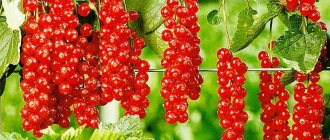
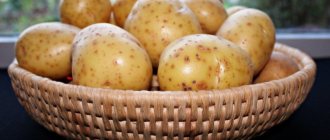

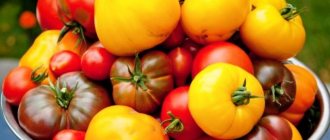

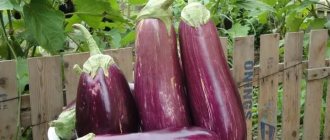
![Tinkoff (Debit card) [CPS] RU](https://adzumi-sushi.ru/wp-content/uploads/tinkoff-debetovaya-karta-cps-ru41-330x140.jpg)
